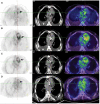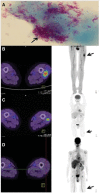Successful treatment of healthcare-associated Mycobacterium chimaera prosthetic infective endocarditis: the first Spanish case report
- PMID: 31020218
- PMCID: PMC6426088
- DOI: 10.1093/ehjcr/yty142
Successful treatment of healthcare-associated Mycobacterium chimaera prosthetic infective endocarditis: the first Spanish case report
Abstract
Background: Since 2011, several cases of health care-related disseminated Mycobacterium chimaera infection outbreaks have been reported subsequent to cardiac surgery. Diagnosis is difficult and the prognosis is extremely poor despite long-term antibiotic treatment and surgery.
Case summary: We report a Spanish case of M. chimaera infective endocarditis (IE) with disseminated infection. The patient was treated with long-term antibiotic therapy, valve replacement, and the novel use of interferon-gamma as adjuvant therapy. In addition, [18F]-fluorodeoxyglucose (FDG) positron emission tomography (PET) was used in combination with computed tomography (CT) to facilitate the diagnosis as well as to determine the duration of antibiotics and success of treatment.
Discussion: Diagnosing M. chimaera IE is difficult and requires a high index of clinical suspicion. Controlling the infection is even more difficult. Interferon-g used adjuvant to surgery and antibiotic therapy could be useful in achieving this goal. Given that the appropriate duration of antibiotics is unknown, FDG PET/CT could also be a valuable tool for determining when antibiotic therapy can be withdrawn.
Keywords: Aortic valve surgery; 18Fluorodeoxyglucose positron emission tomography combined with computed tomography; Case report; Infective endocarditis; Interferon-gamma 1b; Mycobacterium chimaera.
Figures


References
-
- Kohler P, Kuster SP, Bloemberg G, Schulthess B, Frank M, Tanner FC, Rössle M, Böni C, Falk V, Wilhelm MJ, Sommerstein R, Achermann Y, ten Oever J, Debast SB, Wolfhagen MJHM, Brandon Bravo Bruinsma GJ, Vos MC, Bogers A, Serr A, Beyersdorf F, Sax H, Böttger EC, Weber R, van Ingen J, Wagner D, Hasse B.. Healthcare-associated prosthetic heart valve, aortic vascular graft, and disseminated Mycobacterium chimaera infections subsequent to open heart surgery. Eur Heart J 2015;36:2745–2753. - PubMed
-
- Haller S, Höller C, Jacobshagen A, Hamouda O, Abu Sin M, Monnet DL, Plachouras D, Eckmanns T. Contamination during production of heater-cooler units by Mycobacterium chimaera potential cause for invasive cardiovascular infections: results of an outbreak investigation in Germany, April 2015 to February 2016. Euro Surveill 2016;21. - PubMed
-
- Schreiber PW, Sax H.. Mycobacterium chimaera infections associated with heater-cooler units in cardiac surgery. Curr Opin Infect Dis 2017;30:388–394. - PubMed
-
- Sax H, Bloemberg G, Hasse B, Sommerstein R, Kohler P, Achermann Y, Rössle M, Falk V, Kuster SP, Böttger EC, Weber R.. Prolonged outbreak of Mycobacterium chimaera infection after open chest heart surgery. Clin Infect Dis 2015;61:67–75. - PubMed
LinkOut - more resources
Full Text Sources
Molecular Biology Databases
